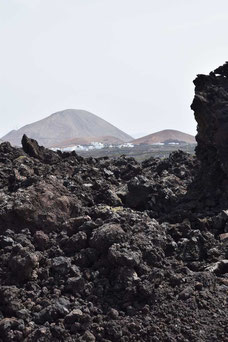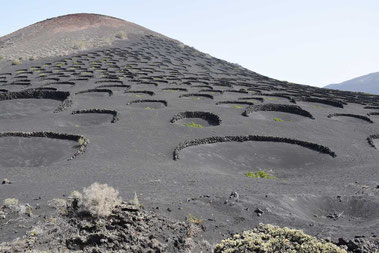Wine tourism in The vineyard of Lanzarote
This is surely one of the most spectacular vineyards in the world. I wanted to discover the island of Lanzarote, in the Canary Islands, and its unique vineyard planted on volcanic ashes for a while. I had this opportunity during the summer of 2022 and I really fell in love with this island. I never get tired of seeing the photos of this vineyard which is so surprising, touching and photogenic.
A semi-desert island

If you don't like rocks, move on! Lanzarote is a volcanic island whose climate is desert and arid. It only rains 10 to 15 days a year, with 110 mm of rain on average. Vegetation is rare and only
certain plants are adapted to this climate: cacti, palm trees, thorny plants... as in the magnificent Cactus Garden created by the artist César Manrique in an old quarry in the south-east of the
island.
In Lanzarote, you have the impression of being on another planet: it's a sensation that arises when the plane starts its descent towards the airport of Arrecife, the capital of the island. From
the sky, three colors dominate: the blue of the Atlantic Ocean, the ocher yellow of the sandy soils and the white of the typical houses of Lanzarote.
At certain times of the year, the island's authorities send yellow, orange, or even red alerts to the population. They are not linked to the risk of thunderstorms like on the continent, but to
potentially scorching temperatures. During red alerts, people must avoid staying outside, as UV rays get too dangerous. Lanzarote is one of the seven islands that make up the Canary Islands
archipelago. It is the most easterly, and it is located only 70 kilometers off the coast of Morocco. Winds from the Sahara sometimes strongly heat up the atmosphere. And as it is close to the
equator, the rays of the sun can be particularly violent.
A volcanic island

While agriculture once spread across the whole of Lanzarote, a good third of the island is today unsuitable for farming. On September 1st 1730, a first volcanic eruption occurred in the southwest of the island. It was followed by continuous eruptions until 1736.
One of Lanzarote's tourist sites is the superb Timanfaya National Park, the heart of the volcanic zone. It can only be visited by bus: as it is a very fragile ecosystem, vehicles are therefore
prohibited, and hiking is not allowed either. So after leaving their cars in the parkplace located at the entrance to the site, visitors get on a bus which takes them for a trip in the park to
see the cones of the now extinct volcanoes. Actually volcanic activity is still closely monitored today.
Part of the island is now covered with solidified lava and volcanic ash. During successive eruptions in the 1730s, the wind scattered this volcanic sand - lapilli, which is called picón in the
Canaries and rofe or arena in Lanzarote - on which the vines of Lanzarote grow nowadays.
The vineyard of Lanzarote
A recent vineyard

The vineyard now spreads on 2,000 hectares. It was developed in the 18th century, mainly in the center of the island, in the valleys of La Geria (a term which also refers to the plantation system, explained below) and Masdache. These areas of the island were covered with volcanic ash during the eruptions that took place in the 18th century. Picón covers the fertile soil and in fact allows the cultivation of vines, as it is a porous rock that captures the humidity carried by refreshing northwest winds due to the Azores anticyclone. The vine feeds on the little water which concentrates in the form of condensation in picón.
The plantation system

The vines are planted in holes called hoyos. This planting system allows the roots of the vines to have access to fertile soil. These holes can reach 3 meters deep and 10 meters in
diameter, depending on the thickness of the picón: the deeper the fertile layer, the deeper and wider the holes.
Located in the middle of the Atlantic Ocean, Lanzarote is an extremely windy island: dry stone walls, called socos, are therefore built around the holes, on half the circumference, to
block the winds and allow the vines, which are not trained, to grow. In the Lanzarote vineyard, work is almost exclusively manual. The harvest - starting mid-July some years, which means
Lanzarote is the first region to harvest in Europe - is done by hand and with crates. In areas where the picón layer is thinner, particularly in the Masdache region, the holes are shallower and
the plantations are done in trenches. The walls are straight, which allows machine work. The yields are a little higher: up to 20 hl/ha... not much, you may say! But the average planting density
is 400 and 600 plants per hectare and yields vary between 1,000 and 1,500 kg/ha (or between 6 and 10 hl/ha, which is equivalent to a 0.75 liter bottle per vinestock).
The wines of Lanzarote

Eighteen bodegas produce wine on Lanzarote, but they often buy the grapes from small owners who grow them on family vineyard plots.
There are 100-percent European vines on the island that are about 200 years old, due to the fact that the vineyard was spared from phylloxera in the 19th century. Grafting is therefore not
necessary and some of the grape varieties grown cannot be found anywhere else - for example, Listán Negro, which is found on other Canary Islands and which makes it possible to produce red wines
with aromas of red fruits and dried fig.
The most widely planted grape variety is Malvasía Volcánica, a grape variety indigenous to Lanzarote, thought to have either originated from a cross between a Malvasia variety and Marmajuelo
(another indigenous Canarian grape variety) or originated from Madeira. Malvasia Volcánica is resistant to drought, high temperatures and wind. It gives low yields, grapes with high acidity,
floral aromas, stone fruit (apricot) and muscat notes. It makes it possible to produce all styles of white wine: sparkling, dry, semi-dry and sweet, with very late harvests compared to the first
grapes harvested.
Which wineries should you visit?

I had the opportunity to visit two bodegas in La Geria.
Bodega El Grifo, founded in 1775, is the oldest winery in the Canary Islands. It offers different possibilities of visits. I opted for the most complete, which allows you to visit the vineyard,
the old colonial-style house, then the old cellars of the estate, where tools and vats are exhibited. Photographs show the work in the vineyard in the past. Camels were used to work in the
vineyards and fields and to transport the harvest. The visit concludes with a tasting of various wines from the estate, accompanied by local cheeses. This wine tasting allows visitors to taste
the most prestigious vintages of the bodega, including a sweet wine made from a blend of grapes harvested in 1956, 1970 and 1997.
At bodega Rubicón, the visit is free. We discover the aging cellars whose walls are lined with barrels of various origins. What I liked about this bodega is the restaurant which allows you to
taste the estate's wines while eating local specialties, while enjoying a breathtaking view on the ancient volcanoes and the vineyard. By the way, what do we eat in Lanzarote? Papas
arrugadas, that is to say “crumpled” potatoes, that are dipped in mojos, local sauces made from green or red pepper and chili pepper, and that are systematically served with bread
at the start of any meal in local restaurants. Fried sheep's cheese, fish of all kinds, meat stews and cactus liqueur are also some of the specialties to try on the island. Without forgetting the
gofio mousse, a dessert made from a mixture of cereals grown on the island.
Apart from wine tourism, what to do in Lanzarote?
Even if you are not a wine lover, you won't remain indifferent to the beauty of the Lanzarote vineyard, which is a must-see on the island. A hike in the vineyards is essential to discover the spectacular landscapes formed by this unique cultivation method. However, the island offers many other sites and attractions.
Discover Cesar Manrique's works of art

Cesar Manrique is the artist and the child of the island, the one who contributed to making it known while seeking to preserve it from mass tourism.
He was born and he died on the island - of a tragic road accident. He left several sites which can be visited and which highlight the volcanic past of the island.
His house is a true work of art, built on two levels, at the foot of a lava field. Lave even gets inside some of the rooms of the house. The ground floor is set in lava bubbles, with different
living rooms and bedrooms with open-air ceilings.
In the Cactus Garden, mentioned above, Manrique sought to collect as many varieties of cacti as possible, brought them from different countries around the world and staged them in an old quarry.
Cacti are magnificent and have unsuspected shapes and flowers: a beautiful, surprising plant heritage.
Jameos del Agua, by the sea in the northeast of the island, is a site imagined in a rock tunnel formed by lava from a volcano located about 3 kilometers from the coast. The place houses a
restaurant, a seawater pool where small albino crabs, unique and endemic to the island, live. The highlight of the site remains the auditorium built in a natural lava bubble, whose acoustics is
perfect thanks to the irregularity and porosity of the volcanic rock.
Finally, the Mirador del Rio, in the north of the island, offers a breathtaking view on the ocean and the island of La Graciosa.
The beaches of Lanzarote

Surrounded by the Atlantic Ocean, Lanzarote is a paradise for swimmers and surfers! Be careful, some beaches are dangerous, as the waves and currents can be very strong.
I really fell in love with Famara beach, located in the northwest of the island. This long beach, made od several kilometers of grey sand, is located below a magnificent cliff which houses an
astronomical observatory. It is a beach where a lot of surfers meet and where I was advised not to swim, but honestly, the waves were not stronger than those on the Atlantic beaches of France.
And the water temperature was ideal for cooling off!
I hope this article has made you want to go and visit in this amazing place. Without a doubt I will return there one day. In any case, this first getaway to the Canaries made me want to explore other islands in the archipelago. On some of them, like Tenerife, vines are also cultivated!





Write a comment